| |
Early HCV Treatment During Acute HCV Within few, 6 Months of Infection with Short-Duration of 4-6 Weeks
|
| |
| |
In the REACT Trial in Early HCV Infection - see below - 6 weeks of SOF/VEL reputed in 89% SVR rates vs 97% and they found - "In a further per protocol analysis which included only participants who were >90% adherent and attended an SVR12 visit (excluding participants who were re-infected or retreated), SVR12 was 93.2% (95% CI 84.9-97.8) in the short arm and 100% (95% CI 95.5-100.0) in the standard arm (p = 0.020)." In the G/P study + RBV study in chronic HCV they found SVR rate of 73% - see link below study results.
Download the PDF here
Download the PDF here
In the REACT study - Sixteen participants within the study experienced virological recurrence at or before SVR12, 12 in the short arm and 4 in the standard arm. Sequencing from baseline and time of recurrence was performed in all 16. Five participants were identified as having reinfection - 4 on the basis of a genotype switch (1a to 3a, 1a to 4d, 3a to 1a, 4d to 1a) and 1 with the same genotype (1a) at both timepoints but with a genetic distance that indicated heterologous virus at relapse (11.4% in core-E2, 9.4% in NS5A). Eleven (5.8%) participants were classified as relapsing (9 [9.6%] in short arm, 2 [2.0%] in standard arm). Although limited by small numbers, no clear association with baseline characteristics was observed, although those with relapse did have a higher median baseline HCV RNA (6.7 log10 IU/ml, 6.8 log10 IU/ml for just those in the 6-week arm) and longer estimated duration of infection (30 weeks across both arms) than those who did not (5.5 log10 IU/ml and 25 weeks, respectively). The proportion with baseline HCV RNA >7 log10 IU/ml was 8% in the study population overall but 36% in the small group who relapsed. All but 1 of the participants with relapse was >95% adherent to therapy. One participant in the standard arm took only 4 weeks of treatment and subsequently relapsed. Of the 11 participants with virological failure, 8 were detected as virological relapse by SVR4, 1 at SVR12 having not been detected at SVR4, and 2 did not attend an SVR4 visit.
You can make a good case that treating early during acute HCV within the first few, 6 months is effective & should be approved and widely implemented, if you can identify the acutely infected person, which is not so easy. AASLD/IDSA recommends treating acute HCV since 2019. It can be cost effective, prevent transmission, and cure an individual's HCV before losing one's immune system's beneficial effects & entering the stage of chronic infection. There are a bunch of reasons to treat early & not wait, as discussed by Arthur Kim, MD, at this years 2021 ID Week meeting in his talk on this issue, here is his list of pros & cons, he all makes the case it can be cost-effective. In Dr Kim's talk at ID Week he discusses that in acute HCV those going onto chronic HCV have higher HCV viral loads & how in REACT in REACT study relapsers had higher viral loads, were older & had longer HCV duration. & Jules Levin, NATAP
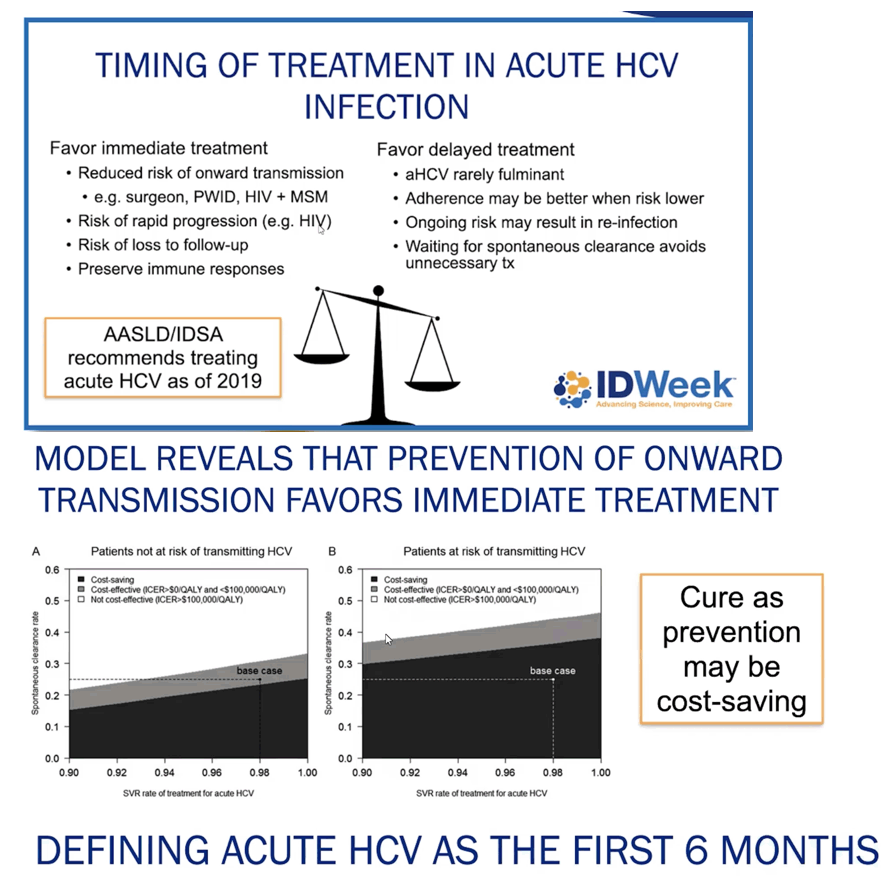
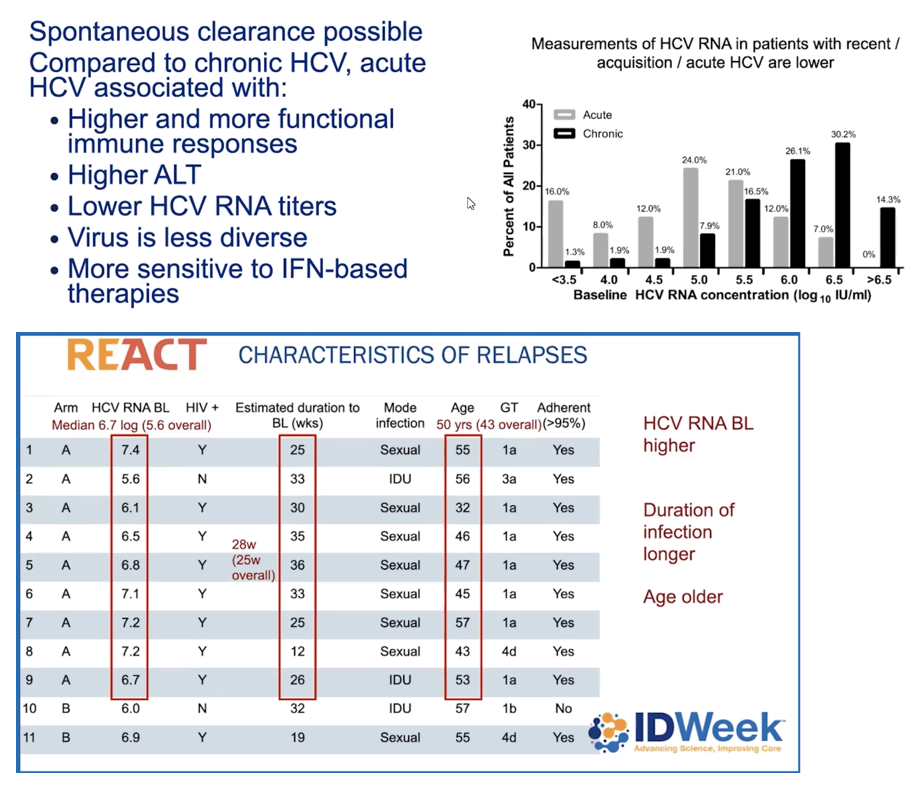
Glecaprevir/Pibrentasvir Fixed-dose Combination Treatment for Acute Hepatitis C Virus Infection (PURGE-C)
https://clinicaltrials.gov/ct2/show/NCT04042740?term=purge&draw=2&rank=3
The study will be conducted in two steps. In Step 1, participants will receive four weeks of treatment with G/P for acute HCV infection and then followed 24 weeks post treatment. Participants with HCV recurrence (reinfection, suspected relapse or undefined post-treatment viremia) or HCV virologic failure before or at the Step 1 Week 16/SVR12 (sustained virologic response 12 weeks post-treatment) visit may enter Step 2 for re-treatment. The remaining participants complete the study at Week 28 of Step 1. The study primary and secondary outcome measures pertain to Step 1.
In Step 2, participants will be re-treated with G/P with or without ribavirin (RBV) for up to 16 weeks, and followed for 24 weeks post treatment. Post-treatment follow-up for Step 2 will include visits for SVR12 determination after re-treatment.
In Step 1, study visits are scheduled at study entry, weeks 1 and 2 (on-treatment), week 4 (treatment discontinuation), and weeks 8, 12, 16 and 28 (post-treatment follow-up). In Step 2, participants will have study visits during the re-treatment period, where the number of visits depends on the re-treatment, and visits at 12 and 24 weeks post treatment. Study visits may include physical examinations, clinical assessments, blood and urine collection, questionnaires, and HCV re-infection prevention counseling.
4 week treatment [G/P+/-Rbv] for hepatitis C - a randomized controlled trial (4RIBC)
https://www.natap.org/2019/EASL/EASL_62.htm
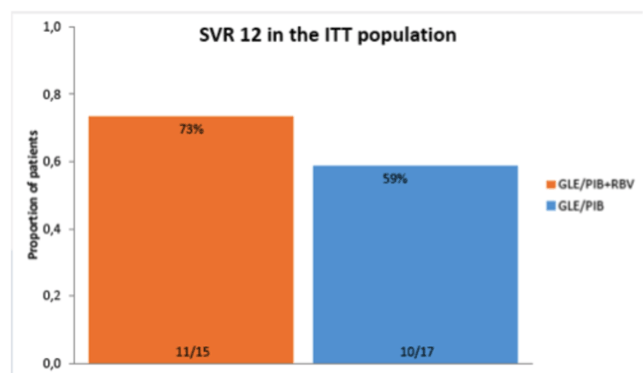
Four weeks of ledipasvir/sofosbuvir and ribavirin with or without pegylated interferon for chronic hepatitis C in non-cirrhotic people who inject drugs. A randomized trial
Pdf attached
We randomized individuals 1:1 to receive four weeks of LDV/SOF 90/400 mg q.d. and RBV q.d. (15 mg/kg max. 1,400 mg) with/without the addition of 180 µg PegIFNα once weekly. The main inclusion criteria were: having CHC of any genotype (defined as two consecutive HCV-RNA positive blood samples within two years), 18-49 years of age, HCV-RNA viral load ≤2,000,000 IU/ml, treatment naïve, weight <100 kg or BMI <30 kg/m2, liver stiffness measurement (LSM) <8 kPa and no signs of liver cirrhosis.
None of the study subjects were eligible for standard of care treatment due to fibrosis (F2 or LSM >10 kPa) treatment restrictions in Denmark (still valid). The study was conducted in April 2015-April 2016 at a single center; the hepatitis clinic at the municipal drug treatment center in Odense, Denmark.
In the intention-to-treat analysis, 94% in the interferon arm and 75% in the interferon-free arm (p = 0.14) achieved SVR12. One patient in the interferon arm and three patients in the interferon free arm dropped-out/lost to follow up making SVR12 in the per protocol population 100% and 92% respectively (p = 0.28).
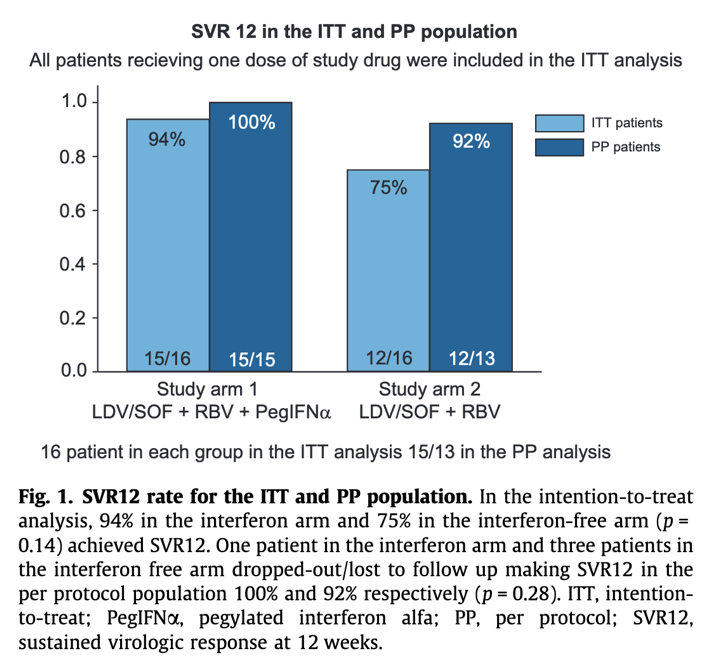
---------------------------------
Sofosbuvir/velpatasvir for 12 vs. 6 weeks for the treatment of recently acquired hepatitis C infection
May 20, 2021
Engagement of individuals early in HCV infection is crucial for HCV elimination efforts. Despite higher relapse in the short arm, REACT confirms that treatment initiated early in infection is safe, feasible and highly effective. Even with a relapse rate of 10% in the short arm, generation of resistance was limited and almost all participants were able to be quickly and successfully retreated. Nevertheless, acknowledging the caveats on generalisability above, REACT clearly demonstrates that, at least in this predominantly HIV-positive population, 6 weeks of sofosbuvir/velpatasvir is suboptimal and patients should be treated with at least an 8-week course
[30]
REACT provides important data on HCV therapeutic intervention outcomes for recent infection among a high-risk population, with implications for individual care and HCV elimination strategies.
In this randomised study of shortened treatment duration for individuals with recent HCV, sofosbuvir-velpatasvir for 6 weeks failed to meet the pre-specified criteria for non-inferiority and the study was terminated early following the second DSMB review. The suboptimal efficacy in the short arm was driven largely by a higher post-treatment relapse, observed in 10% (n = 9) of participants compared with 2% (n = 2) of participants in the standard arm. The REACT study thus found that a 6-week course of sofosbuvir-velpatasvir did not reach non-inferiority against the standard 12-week course in the setting of recently acquired HCV infection and cannot be considered as effective as the 12-week course.
Those with relapse were slightly older, had higher baseline HCV RNA and marginally longer duration of HCV. Although none of these factors could be definitively associated with failure it is notable that the median baseline HCV RNA was 1.3log higher in the 6-week relapsers than in patients who achieved SVR12, and the median duration of infection was 5 weeks longer. This may suggest that patients without these negative prognostic factors may indeed do well with shortened therapy. Failure did not appear linked to the presence of RASs at baseline.
Seven of the 11 participants with relapse had wild-type at baseline and only 1 gained a RAS (L31M) at the failure timepoint. This participant was successfully retreated with sofosbuvir-velpatasvir-voxilaprevir for 12 weeks. Retreatment was left at the discretion of the site investigator and it is noteworthy that almost all participants were retreated and achieved SVR12. These findings are encouraging for salvage from short course therapy and confirm previous findings from studies in chronic HCV infection.[21]
The likely mode of HCV acquisition was deemed sexual exposure in 142 (76%), injecting drug use (IDU) in 40 (21%), non-injecting drug use in 1 (0.5%), occupational exposure in 1 (0.5%), and other or unknown in 4 (2%). Of the sexual acquisitions, the majority (n = 135/142, 95%) were same sex male-male exposures.
In the context of treatment of recent HCV infection among high-risk populations, there is clearly subsequent risk for HCV reinfection. Reinfections were observed in 5 (2.6%) participants at or prior to SVR12, with 4 identified by genotype switch and 1 with the same genotype confirmed through sequencing and genetic diversity evaluation. The study population had high levels of sexual and injecting risk. Although IDU was identified as the most likely route of HCV in only 21%, a history of injecting drugs was reported by 56%, 75% of whom had injected in the prior 6 months. Methamphetamine was overwhelmingly the commonest drug injected. In relation to sexual risk, over half (53%) of participants reported an STI in the prior 12 months and just under half (48%) of the HIV-negative population were receiving pre-exposure prophylaxis (PrEP). New HCV acquisitions among gay and bisexual men using PrEP appear to be increasing in several European countries, and HCV testing should be considered as part of a routine sexual health check among those taking PrEP. Post-SVR12, HCV RNA testing was performed 3-monthly for up to 24 months in the REACT population and will provide important further insights regarding populations at risk for reinfection.
Highlights
• REACT is a randomised study of short course DAA therapy for recently acquired HCV.
• 188 participants were treated with either 6 or 12 weeks sofosbuvir/velapatasvir.
• The study population was predominantly cis-male and included a high proportion living with HIV.
• The study was stopped early due to the high rate of virological relapse in the short course arm.
• Six weeks of sofosbuvir/velapatasvir cannot be considered non-inferior to 12 weeks.
In modified ITT analysis, wherein non-virological reasons for failure were excluded (death, reinfection, loss to follow-up), SVR12 was 76/85, 89.4% (95% CI 80.8-95.0) in the short arm and 86/88, 97.7% in the standard arm (95% CI 92.0-99.7; difference -8.3%, p = 0.025).
Adherence
Overall adherence within the study was good, although it was higher in the short vs. standard arm. Adherence at a level of >80% and >95% was observed in 97% and 95% of participants in the short arm, and 91% and 84% of those in the standard arm (p = 0.13 and 0.031 for >80% and >95% comparisons, respectively) (Table 3).

Treatment efficacy
In the ITT population (n = 188), the ETR was 85/93, 91.4% (95% CI 83.8-96.2) in the short arm and 87/95, 91.6% (95% CI 84.1-96.3) in the standard arm (an absolute difference in proportions of 0.2, p = 0.965). SVR12 in the short arm was 76/93, 81.7% (95% CI 72.4-89.0) and 86/95, 90.5% (95% CI 82.8-95.6) in the standard arm (Fig. 2). The difference between the arms was -8.81 (95% CI -18.6 to 1.0) with the 95% lower confidence bound for the difference falling below the pre-specified level of 12%. The criteria for non-inferiority were therefore not met. Although non-inferiority was not shown, the difference in SVR12 rates between the arms in the ITT analysis was not significant (p = 0.080). A variety of reasons for not achieving SVR12 were observed. Overall, 2 participants died (both in short arm), 8 were lost to follow-up (3 in short arm, 5 in standard arm), 5 were re-infected (3 in short arm, 2 in standard arm) and 11 had virological relapse (9 in short arm, 2 in standard arm) (Table S3).
By modified ITT analysis in which participants with non-virological failure were excluded (including death, reinfection, lost to follow-up), SVR12 was 76/85, 89.4% (95% CI 80.8-95.0) in the short arm and 86/88 97.7% in the standard arm (95% CI 92.3-99.7; difference -8.3, p = 0.025).
In a further per protocol analysis which included only participants who were >90% adherent and attended an SVR12 visit (excluding participants who were re-infected or retreated), SVR12 was 93.2% (95% CI 84.9-97.8) in the short arm and 100% (95% CI 95.5-100.0) in the standard arm (p = 0.020).
Sixteen participants did not achieve ETR by ITT analysis, with 8 participants in each arm. In the standard arm, all 8 cases were considered ETR failures because of missing data (4 of these achieved subsequent SVR12, 3 still had missing data and 1 patient had virological failure at SVR12). In the short arm, 2 cases were because of missing data and 6 had detectable virus measured at ETR. All but 1 of these 6 patients with detectable virus subsequently achieved SVR12. Thus, only 1 patient with documented detectable virus at ETR subsequently had virological failure.
Virological recurrence
Sixteen participants within the study experienced virological recurrence at or before SVR12, 12 in the short arm and 4 in the standard arm. Sequencing from baseline and time of recurrence was performed in all 16. Five participants were identified as having reinfection - 4 on the basis of a genotype switch (1a to 3a, 1a to 4d, 3a to 1a, 4d to 1a) and 1 with the same genotype (1a) at both timepoints but with a genetic distance that indicated heterologous virus at relapse (11.4% in core-E2, 9.4% in NS5A). Eleven (5.8%) participants were classified as relapsing (9 [9.6%] in short arm, 2 [2.0%] in standard arm). All had homologous virus at the time of relapse with a genetic distance in core-E2 of <1.5% compared to baseline. Characteristics of the participants with reinfection and relapse are given in Table 2. Although limited by small numbers, no clear association with baseline characteristics was observed, although those with relapse did have a higher median baseline HCV RNA (6.7 log10 IU/ml, 6.8 log10 IU/ml for just those in the 6-week arm) and longer estimated duration of infection (30 weeks across both arms) than those who did not (5.5 log10 IU/ml and 25 weeks, respectively). The proportion with baseline HCV RNA >7 log10 IU/ml was 8% in the study population overall but 36% in the small group who relapsed. All but 1 of the participants with relapse was >95% adherent to therapy. One participant in the standard arm took only 4 weeks of treatment and subsequently relapsed. Of the 11 participants with virological failure, 8 were detected as virological relapse by SVR4, 1 at SVR12 having not been detected at SVR4, and 2 did not attend an SVR4 visit.
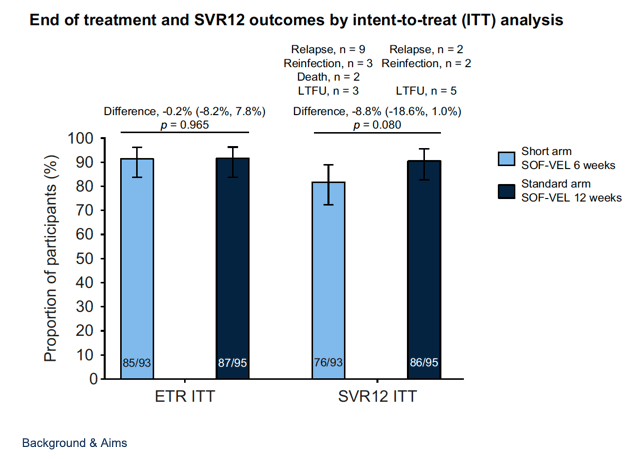
Shortened duration therapy for acute and recent HCV infection has been shown to be highly effective in several small non-randomised studies with direct-acting antiviral regimens; however, large randomised studies are lacking.
Methods
REACT was an NIH-funded multicentre international, open-label, randomised, phase IV non-inferiority trial examining the efficacy of short course (6-week) vs. standard course (12-week) therapy with sofosbuvir-velpatasvir for recent HCV infection (estimated duration of infection ≤12 months). Randomisation occurred at week 6. The primary endpoint was sustained virological response 12 weeks after treatment end (SVR12) in the intention-to treat (ITT) population. A total of 250 participants were due to be enrolled, but on advice of the data safety and monitoring board the study was halted early.
Results
The primary analysis population consisted of 188 randomised participants at termination of study enrolment; short arm (n = 93), standard arm (n = 95). Ninety-seven percent were male and 69% HIV positive. ITT SVR12 was 76/93, 81.7% (95% CI 72.4-89.0) in the short arm and 86/95, 90.5% (95% CI 82.7-95.6) in the standard arm. The difference between the arms was -8.8 (95% CI -18.6 to 1.0). In modified ITT analysis, wherein non-virological reasons for failure were excluded (death, reinfection, loss to follow-up), SVR12 was 76/85, 89.4% (95% CI 80.8-95.0) in the short arm and 86/88, 97.7% in the standard arm (95% CI 92.0-99.7; difference -8.3%, p = 0.025).
Conclusions
In this randomised study in recent HCV infection, a 6-week course of sofosbuvir-velpatasvir did not meet the criteria for non-inferiority to standard 12-week therapy.
Lay summary
In this randomised trial, 188 people with recently acquired hepatitis C infection were randomly assigned to treatment using either a short 6-week course (93 people) or standard 12-week course (95 people) of the hepatitis C treatment sofosbuvir/velpatasvir. There were 9 cases of relapse after treatment with the short course and 2 following the standard course. A shortened course of 6-week therapy for hepatitis C infection appeared to be less effective than a standard 12-week course in people with recently acquired hepatitis C infection.
Resistance and retreatment
All 11 participants with virological relapse were sequenced for the development of NS3 and NS5A resistance-associated substitutions (RASs). Six participants had no evidence of resistance with wild-type virus at baseline and relapse. Three participants had RASs at baseline that remained unchanged at relapse (M31L, n = 1 (GT4d); Q30H + Y93H (Gt1a), n = 1; 62T, n = 1 (Gt3a)). One participant had Y93H at baseline (GT4d) that had reverted to wild-type at relapse and 1 participant had no RAS at baseline and L31M at relapse (GT1a, short arm). Thus, only 1 of 11 participants with virological relapse potentially had treatment-emergent resistance following short course treatment (L31M). Of the 11 participants with virological relapse, 9 were retreated. Retreatment regimens included sofosbuvir-velpatasvir-voxilaprevir (12 weeks, n = 4), sofosbuvir-velpatasvir (12 weeks, n = 1) and glecaprevir-pibrentasvir (8 weeks, n = 4). All achieved SVR12 apart from 1 whose outcome was unknown due to loss to follow-up.
| |
| |
| |
|
|
|